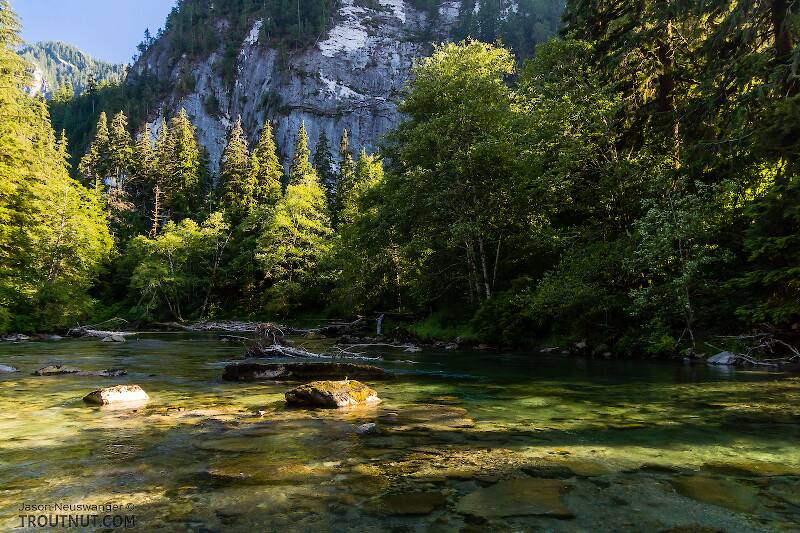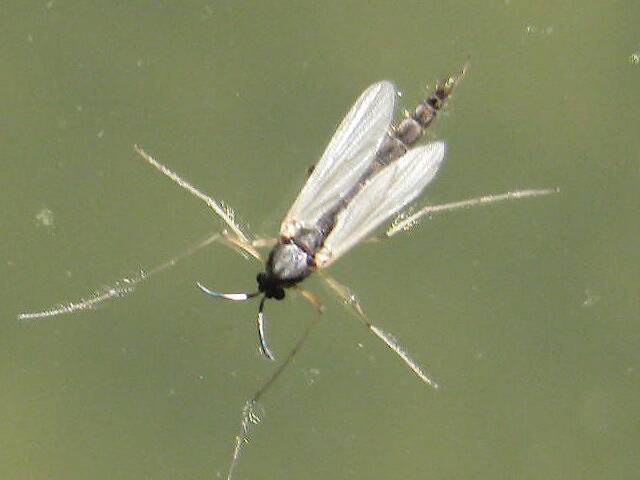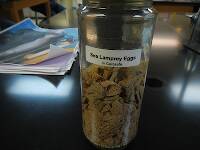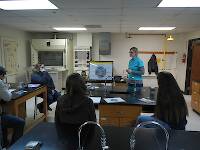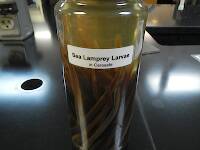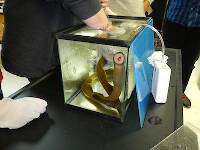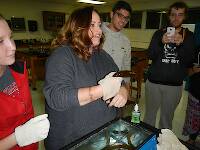
Salmonflies
Pteronarcys californica
The giant Salmonflies of the Western mountains are legendary for their proclivity to elicit consistent dry-fly action and ferocious strikes.
Featured on the forum

This specimen keys to the Epeorus albertae group of species. Of the five species in that group, the two known in Washington state are Epeorus albertae and Epeorus dulciana. Of the two, albertae has been collected in vastly more locations in Washington than dulciana, suggesting it is far more common. On that basis alone I'm tentatively putting this nymph in albertae, with the large caveat that there's no real information to rule out dulciana.

Troutnut is a project started in 2003 by salmonid ecologist Jason "Troutnut" Neuswanger to help anglers and
fly tyers unabashedly embrace the entomological side of the sport. Learn more about Troutnut or
support the project for an enhanced experience here.
Falsifly on Apr 18, 2009April 18th, 2009, 11:06 am EDT
Falsifly
When asked what I just caught that monster on I showed him. He put on his magnifiers and said, "I can't believe they can see that."
When asked what I just caught that monster on I showed him. He put on his magnifiers and said, "I can't believe they can see that."
GONZO on Apr 18, 2009April 18th, 2009, 2:55 pm EDT
Falsifly,
Where did you find this blood-sucking parasite? I believe that L. fluviatilis is a European river lamprey. If the unfortunate brownie is from WI, this might be Icthyomyzon unicuspis (the silver lamprey) or I. castaneus (the chestnut lamprey).
Where did you find this blood-sucking parasite? I believe that L. fluviatilis is a European river lamprey. If the unfortunate brownie is from WI, this might be Icthyomyzon unicuspis (the silver lamprey) or I. castaneus (the chestnut lamprey).
Falsifly on Apr 19, 2009April 19th, 2009, 5:05 am EDT
Thank you Gonzo,
I’m glad I entered the ? in the title. After a little bit of research, following your lead, it appears that you are quite correct. The two: Ichthyomyzon unicuspis and I. castaneus are so closely related in all respects, other than the common name associated with color, that I first assumed I. unicuspis. However, from the few photographs I was able to pull up on the internet, my photos and recollection streamside, I am in doubt as to which.
According to my log entries this is the third trout taken from the Namekagon since 1995 in which the “blood-sucking parasite” was attached.
I would caution anyone from deducing the seemingly rare occurrence of this event, for one must first catch more than a few fish to apply any significance to occurrence. Ha!
I’m glad I entered the ? in the title. After a little bit of research, following your lead, it appears that you are quite correct. The two: Ichthyomyzon unicuspis and I. castaneus are so closely related in all respects, other than the common name associated with color, that I first assumed I. unicuspis. However, from the few photographs I was able to pull up on the internet, my photos and recollection streamside, I am in doubt as to which.
According to my log entries this is the third trout taken from the Namekagon since 1995 in which the “blood-sucking parasite” was attached.
I would caution anyone from deducing the seemingly rare occurrence of this event, for one must first catch more than a few fish to apply any significance to occurrence. Ha!
Falsifly
When asked what I just caught that monster on I showed him. He put on his magnifiers and said, "I can't believe they can see that."
When asked what I just caught that monster on I showed him. He put on his magnifiers and said, "I can't believe they can see that."
GONZO on Apr 19, 2009April 19th, 2009, 6:59 am EDT
Yeah, the silvery belly made me think this might be unicuspis, but according to distribution information on the WI DNR website, castaneus is probably the more likely species in the Namekagon.
Wiflyfisher on Apr 19, 2009April 19th, 2009, 10:55 am EDT
I have caught several trout over the years with those blood-sucking lampreys on their side. I can recall spotting those silvery devils stuck to the side of feeding trout as well. Although it has been sometime since I have seen one in the Namekagon. I was hoping the dams on the St.Croix and lower Namekagon were helping block them from getting into the upper Namekagon any more. I guess I was wrong.
John S.
https://WiFlyFisher.com
https://WiFlyFisher.com
GONZO on Apr 19, 2009April 19th, 2009, 1:35 pm EDT
Hi John,
I'm not sure how dams might affect indigenous river-dwelling lampreys other than making the populations disjunct. I suppose it's even possible that dams on the lower river sections might have the effect of depleting populations below the dams simply by depriving them of spawning habitat.
In any case, indigenous lampreys are reported to have little effect on fish populations. Of course, the "gross-out" factor remains. Apparently, fish feed on lamprey eggs and on the larvae as they drift downstream before burrowing in the mud. It's nice to know that the fish get something out of this relationship other than just holes rasped in their sides by these wretched vampires. Kinda makes me wonder if "ammocoete" imitations might be worth a try at the right time of year on the Namekagon....(?)
I'm not sure how dams might affect indigenous river-dwelling lampreys other than making the populations disjunct. I suppose it's even possible that dams on the lower river sections might have the effect of depleting populations below the dams simply by depriving them of spawning habitat.
In any case, indigenous lampreys are reported to have little effect on fish populations. Of course, the "gross-out" factor remains. Apparently, fish feed on lamprey eggs and on the larvae as they drift downstream before burrowing in the mud. It's nice to know that the fish get something out of this relationship other than just holes rasped in their sides by these wretched vampires. Kinda makes me wonder if "ammocoete" imitations might be worth a try at the right time of year on the Namekagon....(?)
Wiflyfisher on Apr 19, 2009April 19th, 2009, 4:00 pm EDT
It seemed like there were a lot more lamprey around in the mid-80s. The past few years I can't recall seeing many and I thought I had read some where about dams, lamprey traps, or something that were helping stop the migration of lampreys up the St.Croix, but I could be wrong.
BTW, the lampreys on the Namekagon seem like dwarfs compared to the eels I saw on the Delaware River. :)
BTW, the lampreys on the Namekagon seem like dwarfs compared to the eels I saw on the Delaware River. :)
John S.
https://WiFlyFisher.com
https://WiFlyFisher.com
Toga on Apr 21, 2009April 21st, 2009, 8:57 am EDT
I work for Sea Lamprey control out of Marquette, MI and I showed one of my co-workers that more experience with native lamprey's these pictures and he IDed this lamprey as a Chestnut lamprey (Icthyomyzon castaneus ). He said he could just make out the modeling toward the tail that he has seen in the chestnut. He also says this river eventually flows into the Mississippi River and chestnuts are fairly common in this system.
Falsifly on Apr 21, 2009April 21st, 2009, 9:57 am EDT
Toga,
Thank you for the response.
Thank you for the response.
Falsifly
When asked what I just caught that monster on I showed him. He put on his magnifiers and said, "I can't believe they can see that."
When asked what I just caught that monster on I showed him. He put on his magnifiers and said, "I can't believe they can see that."
Imike24
Posts: 1
Posts: 1
Imike24 on May 31, 2009May 31st, 2009, 9:54 pm EDT
Nice
[SIZE=1][FONT=arial]__________________
< />devices < />exercises < />patches < />pills < />breast enhancement < />slimming tablets
[SIZE=1][FONT=arial]__________________
< />devices < />exercises < />patches < />pills < />breast enhancement < />slimming tablets
Martinlf on Jun 1, 2009June 1st, 2009, 10:45 am EDT
Just above, another blood-sucking parasite? A spammer?
"He spread them a yard and a half. 'And every one that got away is this big.'"
--Fred Chappell
--Fred Chappell
Quick Reply
Related Discussions
Topic
Replies
Last Reply
5
Dec 10, 2016
by PaulRoberts
by PaulRoberts
10
May 24, 2009
by Wiflyfisher
by Wiflyfisher
12
Sep 9, 2007
by Martinlf
by Martinlf

